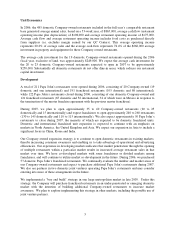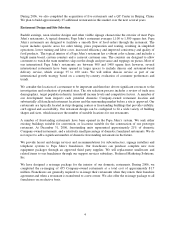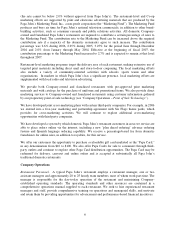Papa Johns 2006 Annual Report Download - page 15
Download and view the complete annual report
Please find page 15 of the 2006 Papa Johns annual report below. You can navigate through the pages in the report by either clicking on the pages listed below, or by using the keyword search tool below to find specific information within the annual report.12
Employees
As of December 31, 2006, we employed 14,743 persons, of whom 12,734 were restaurant team members,
653 were restaurant management personnel, 602 were corporate personnel and 754 were QC Center and
support services personnel. Most restaurant team members work part-time and are paid on an hourly
basis. None of our team members is covered by a collective bargaining agreement. We consider our team
member relations to be excellent.
Item 1A. Risk Factors
This Form 10-K contains forward-looking statements within the meaning of the Private Securities
Litigation Reform Act of 1995 (the “Act”), including information within Management’s Discussion and
Analysis of Financial Condition and Results of Operations. The following cautionary statements are
being made pursuant to the provisions of the Act and with the intention of obtaining the benefits of the
“safe harbor” provisions of the Act. Although we believe that our expectations are based on reasonable
assumptions, actual results may differ materially from those in the forward-looking statements as a result
of various factors, including but not limited to, the following:
1. The ability of the Papa John’s system to continue to open new restaurants is affected by a number of
factors, many of which are beyond our control. These factors include, among other things, litigation,
selection and availability of suitable restaurant locations, increases in the cost of or sustained high
levels of cost of food, paper, utilities, fuel, employee compensation and benefits, insurance and
similar costs, negotiation of suitable lease or financing terms, constraints on permitting and
construction of restaurants, higher than anticipated construction costs, and the hiring, training and
retention of management and other personnel. Accordingly, there can be no assurance that system-
wide, Papa John’s will be able to meet planned growth targets, open restaurants in markets now
targeted for expansion or continue to operate in existing markets profitably.
2. The restaurant industry is intensely competitive with respect to price, service, location and food
quality, and there are many well-established competitors with substantially greater financial and
other resources than the Papa John’s system. Some of these competitors have been in existence for a
substantially longer period than Papa John’s and may be better established in the markets where
restaurants operated by us or our franchisees are, or may be, located. Experience has shown that a
change in the pricing or other marketing or promotional strategies, including new product and
concept developments, of one or more of our major competitors can have an adverse impact on sales
and earnings of Papa John’s and our system-wide restaurant operations.
3. An increase in the cost of cheese or other commodities could adversely affect the profitability of our
system-wide restaurant operations. Cheese costs, historically representing 35% to 40% of our food
cost, and other commodities are subject to seasonal fluctuations, weather, availability, demand and
other factors that are beyond our control. Additionally, sustained increases in fuel and utility costs
could adversely affect the profitability of our restaurant and QC Center businesses.
4. Changes in consumer taste (for example, changes in dietary preferences that could cause consumers
to avoid pizza in favor of foods that are perceived as more healthful), demographic trends, traffic
patterns and the type, number and location of competing restaurants could adversely affect our
restaurant business.
5. Health- or disease-related disruptions or consumer concerns about the commodity supply or the
Company’s food products could negatively impact the availability and/or cost of commodities and
adversely impact restaurant operations and our financial results.
























